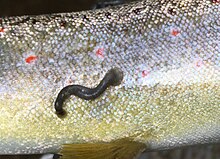| Piscicola geometra | |
|---|---|

| |
| P. geometra parasitizing a river trout | |
| Scientific classification | |
| Domain: | Eukaryota |
| Kingdom: | Animalia |
| Phylum: | Annelida |
| Clade: | Pleistoannelida |
| Clade: | Sedentaria |
| Class: | Clitellata |
| Subclass: | Hirudinea |
| Order: | Rhynchobdellida |
| Family: | Piscicolidae |
| Genus: | Piscicola |
| Species: | P. geometra |
| Binomial name | |
| Piscicola geometra (Linnaeus, 1761) | |
| Synonyms | |
| |
Piscicola geometra is a species of leech in the family Piscicolidae. It is an external parasite of marine, brackish and freshwater fishes. It was first described as Hirudo geometra by the Swedish naturalist Carl Linnaeus in his Systema Naturae in 1758.
Description
This leech can grow to a length of 25 mm (1 in). It is pale brown, often with white transverse bands.
Distribution and habitat
This fish leech occurs in freshwater locations in the Holarctic and Neotropic regions and is found in northwestern Europe and in North America. It is also present in some marine environments such as the Baltic Sea where it mainly parasitises shorthorn sculpin and flounders. It occurs in both moving and stagnant water, but seems to prefer well-oxygenated water at the wave-washed edges of lakes and rapidly flowing streams and rivers.

Ecology
P. geometra is an ectoparasite of various fish species. Hosts include salmon (Salmo salar), brown trout (Salmo trutta), European eel (Anguilla anguilla), charr (Salvelinus alpinus), gudgeon (Gobio gobio), bream (Abramis brama), perch (Perca fluviatilis), Prussian carp (Carassius gibelio) and common carp (Cyprinus carpio). The attachment site is on various parts of the body, on the gills or inside the mouth.
This leech can swim well and is attracted by the presence of a suitable fish in its vicinity. It feeds periodically, attaching itself to the fish's body with its sucking disc before puncturing its skin with its proboscis and sucking its blood. When satiated, it releases its grip and sinks to the bottom, hiding among stones or submerged plants while digesting its meal. It needs several blood meals before it can reproduce. The mid-gut and adjoining mycetomes (pouches), contain symbiotic bacteria which help with the digestion of blood, provide additional nutrients, and prevent the entry of pathogens.
Leeches are hermaphrodite and pair up to impregnate each other by hypodermic injection. The eggs are laid in dark brown cocoons which are cemented to submerged objects. After the eggs hatch, the juvenile leeches must seek out suitable fish hosts. The whole life cycle takes about four weeks to complete.
References
- ^ Kolb, Jürgen (2018). "Piscicola geometra (Linnaeus, 1761)". WoRMS. World Register of Marine Species. Retrieved 18 June 2018.
- ^ Paul, Karen. "Fish leech (Piscicola geometra)". Pond Life. Retrieved 18 June 2018.
- ^ "Piscicola geometra (Linnaeus, 1761)". GBIF. Retrieved 19 June 2018.
- Schäperclaus, Wilhelm (1992). Fish diseases -. CRC Press. p. 871. ISBN 978-90-6191-952-0.
- ^ Rost-Roszkowska, Magdalena M.; Świątek, Piotr; Kszuk, Michalina; Główczyk, Kinga; Bielecki, Aleksander (2011). "Morphology and ultrastructure of the midgut in Piscicola geometra (Annelida, Hirudinea)". Protoplasma. 249 (4): 1037–1041. doi:10.1007/s00709-011-0337-7. PMC 3459081. PMID 22016149.
- ^ Ruppert, Edward E.; Fox, Richard, S.; Barnes, Robert D. (2004). Invertebrate Zoology (7th ed.). Cengage Learning. p. 477. ISBN 978-81-315-0104-7.
{{cite book}}: CS1 maint: multiple names: authors list (link)
External links
 Media related to Piscicola geometra at Wikimedia Commons
Media related to Piscicola geometra at Wikimedia Commons
| Taxon identifiers | |
|---|---|
| Piscicola geometra |
|